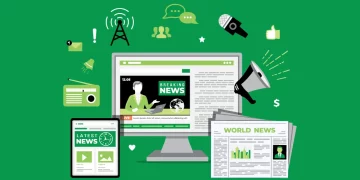Articles are a dominant form of communication in today’s media landscape. They shape opinions, inform decisions, and guide the collective understanding of events, ideas, and trends. In a world where information is constantly being consumed, it is crucial to examine the power articles hold in influencing our perception of reality. Whether in print or digital form, articles mold the way we see the world. This article explores the various dimensions through which articles influence our perceptions, from language choice to media framing, and from narrative structure to psychological impacts.
1. The Power of Language: Shaping Perception Through Words
Language is more than just a tool for communication. It is a vessel through which ideas are transmitted, and more subtly, it influences the way we perceive those ideas. Every word, sentence, and phrase carries not only its literal meaning but also a host of connotations that subtly guide the reader’s interpretation. The artful use of language in articles can evoke specific emotions, frame issues in particular ways, and create a bias without the reader even realizing it.
Take, for instance, the framing of political issues. Words like “reform,” “revolution,” “crisis,” and “disaster” all carry different emotional weights. An article that describes an economic downturn as a “crisis” might provoke fear or urgency, while one that frames it as “necessary adjustment” might suggest hope and gradual recovery. These nuanced differences, while seemingly minor, significantly influence how readers view the same event.
Moreover, the use of metaphors in articles can construct entire worlds in the reader’s mind. A headline that reads “The Economic Engine is Stalling” invokes a mental image of machinery breaking down, suggesting an immediate, possibly catastrophic failure. Alternatively, “The Economic Engine is Shifting Gears” implies a controlled, deliberate transition. Both descriptions present the same event but evoke vastly different perceptions of reality.
2. Media Framing: How News Articles Shape Our Understanding of Events
Framing is a critical technique in media, and articles are its prime vehicle. Media framing refers to the way information is presented and structured, which significantly influences how audiences interpret it. It can involve selecting certain aspects of an issue or event to emphasize while downplaying others. This subtle manipulation of information helps shape a particular narrative, often reinforcing the publication’s ideological stance.

In a political context, framing is particularly important. For instance, the portrayal of a protest in an article can vary greatly depending on the media outlet. One article might frame it as a “grassroots movement for social justice,” while another might call it a “violent disruption of public order.” Both headlines focus on the same event but present it through different lenses, shaping readers’ perceptions in contrasting ways.
Framing extends beyond politics into all areas of life, from social issues to cultural phenomena. The way an article frames an environmental crisis—by highlighting the human cost versus the economic impact, for example—can sway public opinion on policy decisions and personal behaviors. Through framing, articles construct narratives that help us make sense of complex issues, often guiding us to a predefined conclusion.
3. Narrative Structure: How Storytelling in Articles Affects Perception
Humans are naturally drawn to stories. We process information in narrative form because it helps us make sense of the world around us. Articles often use storytelling techniques to engage readers, and the way a story is structured can profoundly influence how we perceive the events being described.
For example, consider an article about a scientific discovery. A well-written piece might introduce the discovery by first narrating the struggles of the scientists involved, then building suspense about their breakthrough, and finally offering the dramatic reveal of the new findings. This structure makes the information more engaging and memorable, but it also directs our focus on the personal journey of the scientists rather than the technical details of the discovery. By guiding attention to certain aspects of the story, articles create emotional connections with the reader, influencing how they perceive both the information and the people involved.
In contrast, an article about the same discovery that is written in a dry, factual manner might place equal weight on the data, the methodology, and the implications of the research, without giving the reader a chance to emotionally connect with the narrative. The difference in structure can make a significant impact on how the reader understands the discovery, its importance, and the people behind it.
4. The Role of Bias: Implicit and Explicit Influences
All articles, whether consciously or not, carry some degree of bias. This bias can be explicit, such as when an article openly takes a stance on a controversial issue, or implicit, where the writer’s personal worldview subtly seeps into the piece. Both forms of bias affect how we understand and interpret the world around us.
In some cases, bias can be overt, such as when an article consistently supports one political party or viewpoint. These articles may actively attempt to persuade the reader to adopt a particular perspective. But even in more neutral-sounding articles, bias is often present in the form of selective reporting. For instance, an article on climate change might highlight the scientific consensus but downplay the dissenting voices, framing the issue in a way that leans toward a specific conclusion.
Implicit bias is even more subtle. For example, the choice of sources can reveal bias. If an article quotes predominantly male experts on a subject like healthcare or education, it might unintentionally reinforce gender stereotypes. The framing of issues, as discussed earlier, can also introduce implicit bias. In many cases, readers may not be aware of the biases influencing their perception because these elements are often woven seamlessly into the narrative.
5. Psychological Impact: How Articles Shape Our Beliefs and Behavior

The psychological impact of reading articles is profound. Articles not only inform but also influence our attitudes, beliefs, and actions. When we read articles, we often internalize the information, which can alter our worldview. Research in psychology shows that repeated exposure to certain types of content can shape our beliefs over time, a phenomenon known as the “illusory truth effect.” The more often we encounter certain ideas, the more likely we are to believe them, even if they are not true.
This is particularly evident in the realm of advertising, where articles designed to sell products or services use persuasive language, emotional appeals, and framing to convince readers that they need something. In the political realm, repeated exposure to certain narratives can reinforce ideological beliefs. An individual who regularly consumes articles from a specific political ideology is likely to adopt those viewpoints, reinforcing existing biases.
Moreover, the emotional appeal in articles can also influence behavior. For example, an article highlighting the negative effects of smoking can evoke guilt and fear, potentially leading a reader to quit smoking. Conversely, an article about the health benefits of exercising might inspire someone to become more active. By shaping our emotions, articles can trigger specific actions, further demonstrating their power in shaping reality.
6. The Influence of Visuals: How Images Complement the Article’s Message
In today’s digital world, articles are rarely presented without images. Visuals—whether photos, infographics, or illustrations—play a key role in reinforcing the message conveyed by the text. The combination of visuals and text creates a more immersive experience for readers and reinforces the emotional and cognitive impact of the article.
An image can evoke emotions more quickly than words alone. A photograph of a war-torn city, for instance, can stir feelings of sympathy and outrage, amplifying the message of an article about human rights abuses. Similarly, an infographic summarizing complex data can make the information more accessible and memorable, aiding the reader’s understanding of the subject.
The strategic use of images also has a significant impact on perception. For example, a photo of a smiling child with a clean water bottle in an article about a charitable organization can create a sense of hope and positivity. Conversely, images of overcrowded refugee camps in an article about migration can evoke a sense of crisis and urgency. Visuals, much like language, can subtly direct the reader’s interpretation and influence their perception of reality.
Conclusion: The Interwoven Power of Articles in Shaping Reality
Articles are not just vehicles for transmitting facts—they are powerful instruments that influence how we understand the world. From the words used to describe an event to the images that accompany the text, articles shape our perceptions, emotions, and beliefs. Whether through subtle framing, narrative structure, or the psychological effects of repeated exposure, articles mold our sense of reality in profound ways.
In a time of information overload, it is more important than ever to approach articles with a critical mind. By understanding the mechanisms through which articles shape perception, we can become more aware of the biases and narratives they contain. This awareness allows us to better navigate the media landscape and form more balanced, informed views of the world.



















































